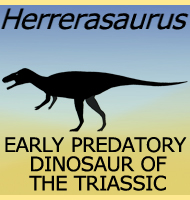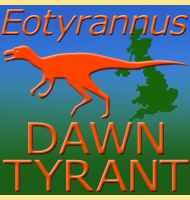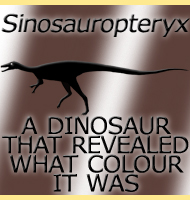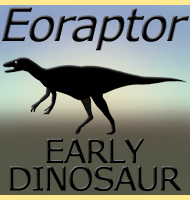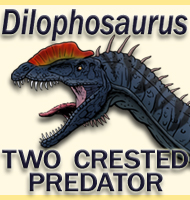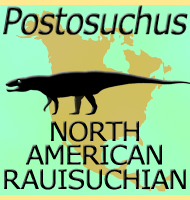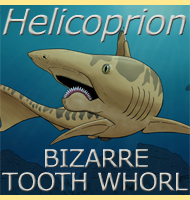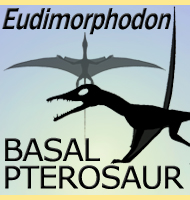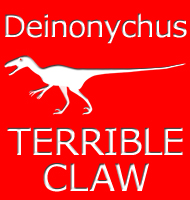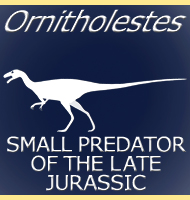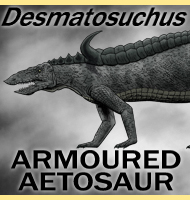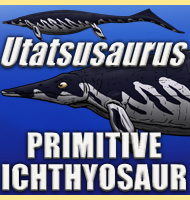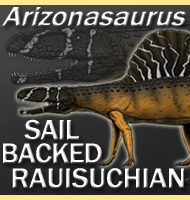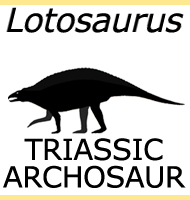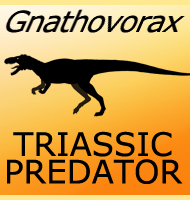


Coelophysis
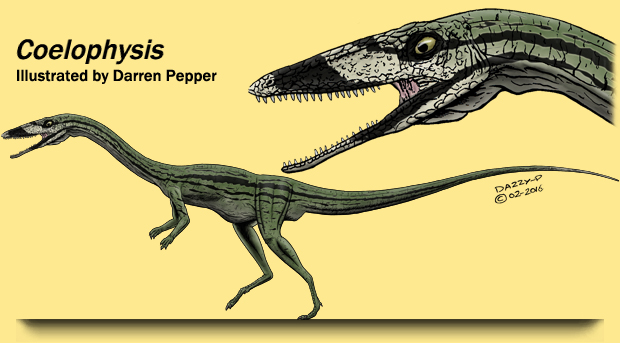
Name: Coelophysis
(Hollow form).
Phonetic: See-lo-fie-sis.
Named By: Edward Drinker Cope - 1889.
Synonyms: Longosaurus, Megapnosaurus,
Rioarribasaurus. Possibly Gojirasaurus?,
Podokesaurus?.
Classification: Chordata, Reptilia, Dinosauria,
Saurischia, Theropoda, Coelophysidae, Coelophysinae
Species: C. bauri (type), C.
kayentakatae, C. rhodesiensis. Possibly C.
holyokensis.
Type: Carnivore.
Size: 2.8-3 meters long.
Known locations: USA, New Mexico and Arizona.
Quite possibly other areas of the US and even further afield.
Time period: Carnian to Norian of the Triassic.
Fossil representation: Many specimens are known,
in fact they are so numerous the exact figure is not easy to establish.
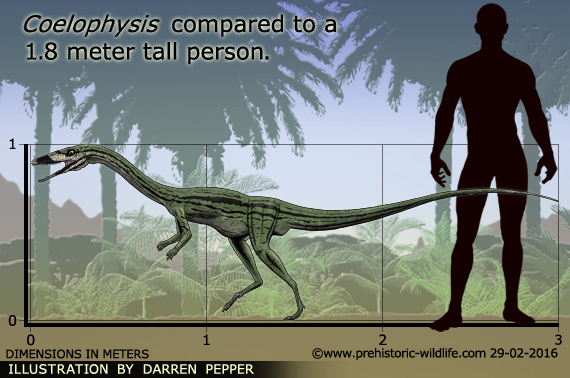
Coelophysis
is frequently used as an example of the early dinosaurs. Its bipedal
stance from two legs that supported its body from underneath as opposed
to sticking out to the sides, smaller arms and head mounted on an
'S curved' neck give it the distinctive theropod look. Coelophysis
also had sharp recurved teeth that were serrated on the front and back
edges, making them perfect for slicing.
Inside,
the limb bones were
hollow making Coelophysis very light. This
combined with the long
legs mean that Coelophysis would have been able to
easily cover a
greater distance in the search for prey, suggesting that Coelophysis
most probably lived the life of an opportunistic carnivore in that not
only did it hunt for small animals, it may have actively sought out
carrion as well.
It
was long assumed that
Coelophysis was cannibalistic. This view was based
upon the remains
of smaller creatures found in what would have been the gut of
Coelophysis. Although upon first glance they
appeared to be
Coelophysis juveniles, later study in 2002 by
Rob Gay proved that
they were the bones of reptiles that belonged to the crurotarsan
group. These reptiles were common during this time of the Triassic,
and the evidence now points to the crurotarsan reptiles forming a key
part of the diet of Coelophysis, at least in this
fossil location.
Coelophysis
remains can be
sub divided into robust and gracile forms, and it is now thought that
these represent males and females of the species. This sexual
dimorphism is also clearly seen in group concentrations of Coelophysis
remains, and shows that they would at times cluster together. It is
still unknown if this is evidence of an established pack, or just a
number of individuals taking advantage of an abundant food source like
can be seen with bears fishing for salmon in rivers today.
The
most famous group
concentration of Coelophysis comes from the Ghost
Ranch deposit
discovered in 1947. It is thought by many that the Coelophysis
individuals deposited there were killed by a flash flood, something
that is considered to have been a frequent occurrence during this
time. The specimens recovered from this deposit were in a much better
state of preservation than the early fossils that had been described by
Cope in 1889, and because of this, the phylogenetic position of
Coelophysis would need to be shuffled around.
The
original type specimen
was in a very poor state of preservation, so poor in fact, some
were uncertain about the legitimacy of assigning the Ghost Ranch
specimens to the name Coelophysis. In 1991
the new name of
Rioarribasaurus was assigned to these specimens but
quickly contested
on the grounds that the majority of the knowledge, written material
and reconstruction of Coelophysis was based upon
the Ghost Ranch
fossils. Considering the arguments of the petition the ICZN voted to
restore the name Coelophysis, and also decreed
that a new type
specimen of Coelophysis be taken from the Ghost
Ranch deposits so that
new specimens may be referred against more complete material. A
consequence of this decision was Rioarribasaurus
becoming a nomen
rejectum (meaning 'rejected name'), and has since been placed
as a synonym to Coelophysis.
Further
to the above, some
palaeontologists also think that a later dinosaur named Megapnosaurus
is actually a late surviving Coelophysis. Support
for this comes from
striking similarities between the two dinosaurs. If it can be proven
that Megapnosaurus is a synonym, the temporal
range of Coelophysis
would extend beyond the Norian and well into the early Jurassic.
Further reading
- Podokesaurus holyokensis, a new dinosaur from the
Triassic of the
Connecticut Valley. - American Journal of Science. 4 31: 469–479. - M.
Talbot - 1911.
- The Triassic dinosaur genera Podokesaurus and Coelophysis.
- American
Museum Novitates 2168: 1–12. - E. Colbert - 1964.
- Rioarribasaurus, a new name for a Late Triassic dinosaur from New
Mexico (USA). - Pal�ontologische Zeitschrift. 65 (1/2): 191–198. - A.
P. Hunt & S. G. Lucas - 1991.
- Coelurus bauri Cope, 1887 (currently Coelophysis
bauri; Reptilia,
Saurischia): Proposed replacement of the lectotype by a neotype. -
Bulletin of Zoological Nomenclature. 49 (4): 276–279. - E. H. Colbert,
A. J. Charig, P. Dodson, D. D. Gillette, J. H. Ostrom & D. B.
Weishampel - 1992.
- Geology and taphonomy of the Coelophysis quarry,
Upper Triassic
Chinle Formation, Ghost Ranch, New Mexico. - Journal of Paleontology 68
(5): 1118–1130. - Hilde L. Schwartz, David D. Gillette - 1994.
- Opinion 1842: Coelurus bauri Cope, 1887
(currently Coelophysis bauri;
Reptilia, Saurischia): lectotype replaced by a neotype. - Bulletin of
Zoological Nomenclature 53 (2): 142–144. - International Commission on
Zoological Nomenclature - 1996.
- Eucoelophysis baldwini, a new theropod dinosaur
from the Upper
Triassic of New Mexico, and the status of the original types of
Coelophysis. - Journal of Vertebrate Paleontology19.
- R. M. Sullivan
& S. G. Lucas - 1999.
- An unusual adaptation in the caudal vertebrae of Coelophysis
bauri
(Dinosauria: Theropoda). - PaleoBios 21: 55. - R. J. Gay - 2001.
- Forelimb bio-mechanics of non-avian theropod dinosaurs in predation.
- Senckenbergiana Lethaea 82: 59–76. - K. Carpenter - 2002.
- The myth of cannibalism in Coelophysis bauri. -
Journal of Vertebrate
Paleontology 22 (3): 57A. - R. J. Gay - 2002.
- Preliminary statistical analysis defining the juvenile, robust and
gracile forms of the Triassic dinosaur Coelophysis.
- Journal of
Vertebrate Paleontology 21: 93. - L. F. Rinehart, S. G. Lucas &
A. B. Heckert - 2004.
- A juvenile coelophysoid skull from the Early Jurassic of Zimbabwe,
and the synonymy of Coelophysis and Syntarsus.
- Palaeontologia
Africana 40: 31–41. - A. Bristowe, & M. A. Raath - 2004.
- The sclerotic ring of the Late Triassic theropod dinosaur
Coelophysis. - New Mexico Geological Society Spring
Meeting 26: 64.- L.
F. Rinehart, A. B. Heckert, S. G. Lucas & A. P. Hunt - 2004.
- Prey choice and cannibalistic behaviour in the theropod Coelophysis.
- Biology Letters. 22 2 (4): 611–614. - S. J. Nesbitt, A. H. Turner, G.
M. Erickson & M. A. Norell - 2006.
- Furculae in the Late Triassic theropod dinosaur Coelophysis
bauri. -
Pal�ontologische Zeitschrift 81 (2): 174–180. - L. F. Rinehart, S. G.
Lucas & A.P. Hunt - 2007.
- A critical re-evaluation of the Late Triassic dinosaur taxa of North
America. - Journal of Systematic Palaeontology 5 (2): 209–243. - S. J.
Nesbitt, R. B. Irmis & W. G. Parker - 2007.
- The paleobiology of Coelophysis bauri (Cope) from
the Upper Triassic
(Apachean) Whitaker quarry, New Mexico, with detailed analysis of a
single quarry block. - New Mexico Museum of Natural History &
Science, a division of the Department of Cultural Affairs Bulletin 45:
260. - L. F. Rinehart, S. G. Lucas, A. B. Heckert, J. A. Spielmann
& M. D. Celesky - 2009.
Random favourites
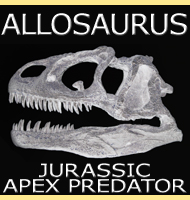 |
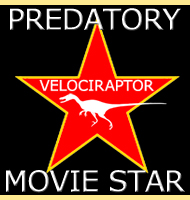 |
 |
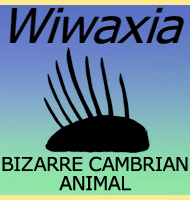 |
